Keflex Alternatives: Safer Choices When Cephalexin Isn’t Right
Keflex (cephalexin) is a common antibiotic, but it won’t always be the best pick. Maybe you have a penicillin allergy, your infection could be resistant, or the bug is MRSA — in those cases, other antibiotics work better. Below I list practical alternatives by infection type, what they cover, and quick tips to help you decide what to ask your prescriber.
Common Alternatives by Infection
Skin infections (cellulitis, abscesses): If the infection looks non-purulent (red, spreading, likely strep), cephalexin often works. If you’re allergic to beta-lactams, or MRSA is possible, try clindamycin, doxycycline, or TMP-SMX. Clindamycin covers strep and some MRSA but can cause diarrhea; doxycycline and TMP-SMX are good MRSA options. For an abscess, incision and drainage plus a cover for MRSA is often the right move.
Urinary tract infections (UTIs): Cephalexin can treat some UTIs, but nitrofurantoin, trimethoprim-sulfamethoxazole (TMP-SMX), and fosfomycin are commonly used alternatives. Nitrofurantoin is great for uncomplicated lower UTIs; fosfomycin is a single-dose option in some places. Choice depends on local resistance patterns, your kidney function, and pregnancy status.
Respiratory infections: For community-acquired sinusitis or bronchitis where cephalexin is considered, amoxicillin-clavulanate or doxycycline may be better choices, especially if Haemophilus or beta-lactamase–producing organisms are suspected. For strep throat, plain penicillin or amoxicillin usually remains the first-line option.
How to Pick the Right Alternative
Start with three questions: What part of the body is infected? Do you have drug allergies? Could MRSA be involved? Your answers narrow the list fast. If the infection is severe, deep, or you’re systemically unwell, get evaluated quickly—IV antibiotics or hospital care might be needed.
Ask your provider for a culture when possible (wound swab, urine, throat). Culture results let clinicians pick an antibiotic the bug is actually sensitive to. Also mention pregnancy, breastfeeding, liver or kidney problems, and other meds you take—these change which drugs are safe.
A word on safety: every antibiotic has downsides—gut upset, yeast infections, allergic reactions, and antibiotic resistance risk. MRSA won’t respond to cephalexin, so if the wound is draining or you’ve had MRSA before, point that out. If you have a true severe penicillin allergy (anaphylaxis, hives), discuss non-beta-lactam options only.
If you’re unsure which alternative fits you, call your doctor or pharmacist. They can match your medical history, local resistance data, and the exact infection to the best, safest option. Quick action and the right antibiotic make a big difference.
Alternatives to Keflex: What to Prescribe If Your Patient Is Allergic
Stuck when your patient breaks out in hives after Keflex? This article digs deep into what to prescribe instead. Find out how cross-reactivity really works, which antibiotics are safest, and how skin testing protocols can clear confusion. With practical facts, real clinical tips, and a handy reference chart, you'll be prepped to make fast, evidence-based choices when Keflex isn’t an option.






